- Data & Statistics
Access Quick Stats (searchable database)
The Quick Stats Database is the most comprehensive tool for accessing agricultural data published by NASS. It allows you to customize your query by commodity, location, or time period.
Access Quick Stats Lite
Quick Stats Lite provides a more structured approach to get commonly requested statistics from our online database.
Explore Statistics
County Level Information
Geospatial Data & Interactive Maps
- Publications
Browse NASS Reports
- by Subject
- by Date (Reports Calendar)
- by Title/Release Day
- by Keyword
- Guide to Products and Services
Additional Reports
Historical Publications
- Archived Ag Census Reports (2002 and prior - published every 5 years)
- Annual Agricultural Statistics
- Statistical Bulletins (final estimates, 1987 to 2012
- Track Records: (crops, livestock, grain stocks)
- Trends 20th century
- Price Reactions (after crop or livestock reports)
Receive Reports by Email:
- Newsroom
News Releases
12/23/25 United States hog inventory up 1%
12/15/25 USDA Launches Final Phase of 2025 Agricultural Resource Management Survey
12/10/25 USDA to Conduct 2025 Organic Survey
09/30/25 US corn ending stocks down 13% from last year, soybean ending stocks down 8%
09/29/25 USDA to Host Data Users’ Meeting to Gather Public Input on Statistical Programs
Read More News
ASB Notices
12/22/25 USDA NASS reschedules reports due to December 24 & 26 government closure
11/19/25 USDA Reschedules Reports Affected by Lapse in Federal Funding
10/31/25 USDA’s National Agricultural Statistics Service (NASS) will release key data in November
08/28/25 NASS discontinues select data collection programs and reports
03/19/25 NASS reinstates select data collection programs and reports
Read More Notices
Videos
02/13/24 2022 Census of Agriculture Data Highlights
02/13/24 How to Find 2022 Census of Agriculture Data
02/13/24 2022 Census of Agriculture Data Release Event
07/16/21 What is a Farm?
08/05/20 The NASS Mission: We do it for you
View More Videos
ASB Briefings
12/23/25 Hogs and Pigs (Decemer 2025)
12/09/25 Crop Production (December 2025)
11/14/25 Crop Production (November 2025)
09/30/25 Small Grains Summary and Grain Stocks (September 2025)
09/25/25 Hogs and Pigs (September 2025)
View More Briefings
- Surveys
- Census
- About NASS
Structure and Organization
- Agency Overview
- NASS Biographies
- Organizational Chart
- Assistance to Other Organizations
- International Programs
- Talking About NASS - A guide for partners and stakeholders
- NASS Strategic Plan for FY 2022-2026
- USDA Strategic Goals
Guiding Principles
- Mission and Core Values
- Keeping Data Safe
- Confidentiality Pledge
- Security Pledge
- Security Statement
- Statement of Commitment to Scientific Integrity
- Regulations Guiding NASS
- Information Quality
- Learning Agenda, Fiscal Year 2024 -2026
Civil Rights
Work at NASS
Education and Outreach
- Understanding Ag Statistics
- Data Users' Meetings
- Morris Hansen Lecture
- International Conference on Agricultural Statistics
History and Procedures
- Agricultural Statistics Board and Lockup
- Agricultural Statistics: A Historical Timeline
- The Story of U.S. Agricultural Estimates
- As We Recall: The Growth of Agricultural Estimates, 1933-1961
-
Safeguarding America's Agricultural Statistics Report and Video
- History of Ag Statistics
- Report Procedures
- An Evolving Statistical Service
- Fact Finders for Agriculture
- Hall of Fame
- Contact Us
Mailing Address:
USDA-NASS
1400 Independence Ave., SW
Washington, DC 20250Survey FAQs and Contact Us:
Access FAQs or submit a question.
Data Inquiries:
Hours: 8:00 a.m. - 5:00 p.m. Central Standard Time
Monday - Friday, except federal holidays
Toll-Free: (800) 727-9540Media Inquiries:
Other USDA Inquiries:
Hours: Monday to Friday 8 a.m. - 5 p.m. EST
Toll-Free: (833) One-USDA
Email: askusda@usda.gov
Website: https://ask.usda.gov/s/Translation Services:
Regional and State Field Offices:
Find contact information for Regional and State Field Offices
Ask a Specialist:
Have a specific question for one of our subject experts? Contact a specialist.
Web Content Publishing Schedule:
Section 207(f)(2) of the E-Government Act of 2002 requires federal agencies to develop an inventory of information to be published on their Web sites, establish a schedule for publishing information, make those schedules available for public comment, and post the schedules and priorities on the Web site.
- Help
Technical Issues
Highlights
Turkey Industry Overview
- April 2014 | No. 2014-2 | Download the PDF version
- Turkey Hatcheries
- Slaughter Numbers
- Turkey Production Value
- Top Turkey-Producing States
- Survey Methodology
- Terminology
- Information Contacts
U.S. farmers have carefully bred turkeys to become efficient meat producers and continue to make strides in production efficiency even today. In 2013, turkeys weighed an average of 30.3 pounds, an increase of 1.3 pounds since 2008, when average weight was 29.0 pounds. This gain can be traced back for several decades and is directly related to genetic selection, technical advancements, and better production management.
Higher production efficiency, achieved by the increase in an average per bird weight and technological advances, led to a reduction in total turkeys raised per year. While in 2008, U.S. farmers raised 273 million turkeys, in 2013 that number is 240 million (Figure 1). But even as the number of birds declined, total pounds of turkey produced remained relatively steady during the past five years. The value of U.S. turkey production climbed up from $4.48 billion in 2008 to $4.84 billion in 2013.
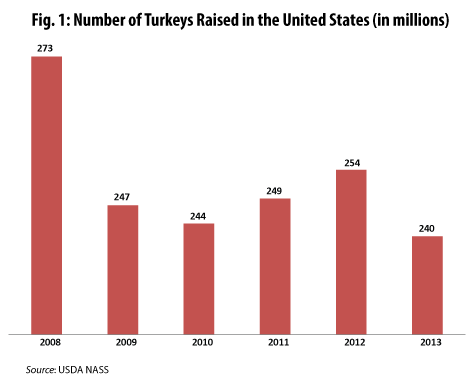
Average Hatchery Capacity Reached Record High in 2012
Producing turkeys involves numerous specialized facilities. Turkeys produce eggs in laying facilities, some of which have maintained the same genetic turkey breed for more than a century. Once eggs are laid, producers ship them to hatcheries where they get set in incubators, or stored for a short period of time for later use.
For several decades, the number of turkey hatcheries has declined steadily. During the last six years, however, this decrease began to slow down. As of 2013, there are 54 turkey hatcheries in the United States, down from 58 in 2008, but up from the historical low of 49 reached in 2012 (Figure 2).
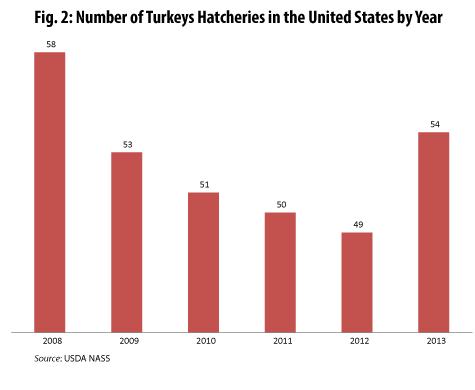
The total capacity of these facilities remained steady during this period at approximately 39.4 million eggs (Figure 3).
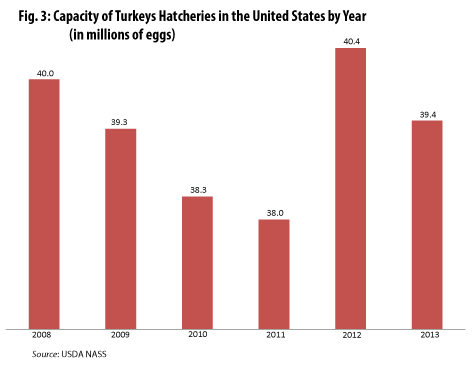
The average capacity per hatchery reached a record high in 2012. During 2013, average capacity per hatchery was 730 thousand (data records are available from 1965 to present) (Figure 4).
Slaughter Numbers by Year

Once the poults hatch, the hatcheries ship them to brooder barns. As these poults mature, they move to grow-out facilities until they reach their appropriate slaughter weight (although some operations use the same building for the entire grow-out process). Regardless of the grow-out method used, once the turkeys reach slaughter weight, most operations ship them to slaughter facilities, where the turkeys are processed for meat products or sold as whole birds.
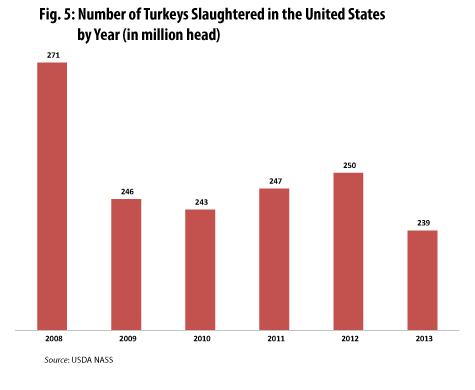
A $5-Billion Industry
On the financial side, the value of turkey meat production in the United States increased over the past 5 years. In 2008, the value of turkey production reached $4.48 billion. By 2012, the value of production increased 21 percent to $5.45 billion. In 2013, the value of production dropped 11 percent to $4.84 billion.
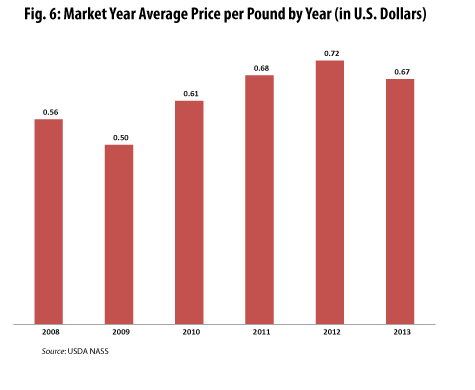
The value of production is driven by the per pound price received by U.S. turkey growers. These prices have climbed since 1975, a path they continued through 2012, when prices remained above 70.0 cents per pound for most of the year. Since 2008, this price has fluctuated between the low of 43.8 cents per pound, reached in January 2009, and the high of 78.1 cents per pound, reached in November 2011. Beginning in December 2012, however, U.S. turkey prices came down. During 2013, U.S. turkey growers received a monthly average price of 66.6 cents per pound (Figure 6).
Top Turkey-Producing States in 2013
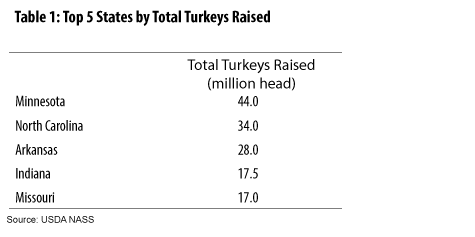
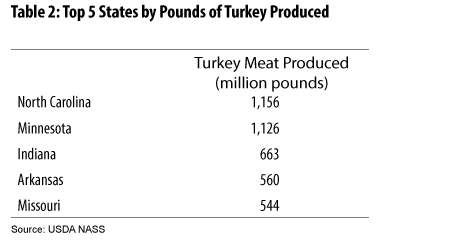
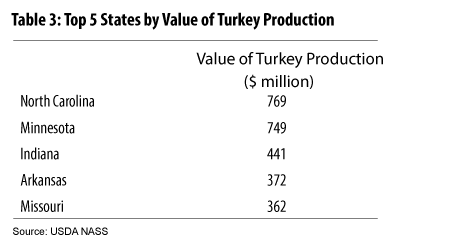
About This Publication
These industry highlights summarizing turkey production in the United States are second in a series of summaries drawn from the regular series of surveys that USDA’s National Agricultural Statistics Service (NASS) conducts and publishes. The data included here cover the period from 2008 to 2013.
NASS previously published the Overview of the U.S. Turkey Industry report on November 9, 2007, which provided industry highlights from 1975 to 2007.
Survey Methodology
Hatchery Survey Procedures: Data for turkey hatchery estimates are collected from all known turkey hatcheries. Individual NASS field offices maintain a list of all known turkey hatcheries and use known sources of hatcheries to update their lists. Approximately 40 hatcheries are contacted each month. All known turkey hatcheries hatching 15,000 or more poults annually are mailed a questionnaire as close to the first of the month as possible. Adequate time is given to respond via mail, fax, or electronic data reporting (EDR). Those that do not respond are contacted by phone. Care is exercised to ensure that all hatcheries are accounted for in the estimate.
Hatchery Estimating Procedures: Sound statistical methodology is employed to derive the estimates from reported data. All data are analyzed for unusual values. Data from each operation are compared to their own past operating profile and to trends from similar operations. Data for missing operations were estimated based on similar operations or historical data. NASS field offices prepare these estimates by using a combination of survey indications and historic trends. Individual State estimates are reviewed by the Agricultural Statistics Board for reasonableness. Individual hatchery data are summed to State, regional, and United States totals. Only United States level estimates are published due to the limited number of hatcheries involved. The Net Poult Placement data include imported poults and exclude exported poults.
Cumulative net poult placements beginning on September 1 and ending on August 31 are shown in the monthly Turkey Hatchery report. This time period corresponds with the placements of poults which will reach maturity and be available for slaughter during the calendar year.
States reporting turkey hatcheries are: Arkansas, California, Florida, Idaho, Indiana, Iowa, Massachusetts, Michigan, Minnesota, Missouri, North Carolina, New Mexico, Ohio, Pennsylvania, Texas, Virginia, West Virginia, and Wisconsin.
Raised Survey Procedures: A random sample of approximately 600 United States turkey producers was surveyed to provide data for these estimates. Survey procedures ensured that all turkey producers, regardless of size, had a chance to be included in the survey. Large operations were sampled more heavily than small operations. The data collected were received by electronic data reporting (EDR), mail, telephone, and face-to-face personal interviews.
Raised Estimating Procedures: Turkeys raised preliminary estimates include young turkeys intended for meat production and breeder turkeys reaching maturity during the calendar year. These estimates exclude turkeys lost to disease or those destroyed. Placement of turkey poults from the monthly Turkey Hatchery Survey and indications from the September Turkeys Raised Survey provide the basis for the preliminary estimates published in September. Final estimates, published in April, use indications from the February Turkeys Raised Survey in addition to updated hatchery data. Other indications for the final estimates are obtained from monthly slaughter totals and check-off data provided by individual State turkey or poultry associations.
Terminology
Beard: A black lock of hair found on the chest of a male turkey.
Breed designations: Light breed or fryer-roaster turkeys are generally marketed between 5 and 10 pounds live weight; heavy breed turkeys normally exceed 12 pounds live weight. NASS no longer estimates the breakdown between heavy and light breeds.
Breeder hen: Mature hens to be used for fertile egg production to supply the hatchery. To maintain production continuity, laying turkey hens are artificially inseminated. The use of light induces them to lay at optimum times. During a 25 week laying cycle a hen normally lays 80-100 eggs. At the end of the cycle, the hen is “spent” and is usually slaughtered.
Brooder: Temperature controlled facilities where brooding stoves, hanging from the ceiling, radiate heat down onto the poults keeping them warm. Feeders and waterers are placed close to the heat. At 5-6 weeks of age the poults are moved to "growout" facilities.
Caruncle: A red-pink fleshy growth on the head and upper neck of a turkey.
Death loss: Turkeys that die due to disease, natural causes, or catastrophe before reaching market weights.
Eggs: Turkey eggs are tan with brown specks and are larger than chicken eggs.
Flock: A large group of turkeys.
Hen: Female turkey.
Incubation period: The period of time required for a turkey egg to hatch is 28 days.
Poult: Baby turkey and it is usually tan and brown.
Poults placed: Poults placed on farms in all states for meat production or breeding. Poults exported or die en route to farms are excluded while extras supplied by hatcheries are included.
Snood: A long, red, fleshy growth from the base of the beak that hangs down over the beak.
Information Contacts
Listed below are the commodity specialists in the Livestock Branch of the National Agricultural Statistics Service to contact for additional information. E-mail inquiries may be sent to nass@nass.usda.gov.
Dan Kerestes, Chief,
Livestock Branch
(202) 720-3570
Bruce Boess,
Head, Poultry and Specialty Commodities Section
(202) 720-4447
Michael Klamm
Poultry Slaughter, Turkey Hatchery, Turkeys Raised
(202) 690-3237
Last Modified: 04/30/2021

